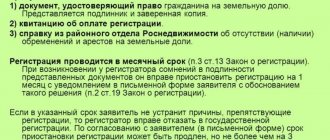Every transaction made with land must be registered with Rosreestr. Therefore, after the parties sign a document for the purchase and sale of a plot of land, papers confirming the fact of transfer of ownership rights must be transferred to this government department. But not every city has it, so citizens of the Russian Federation are given the opportunity to draw up a contract for the sale and purchase of a land plot through the MFC.
Who can draw up an agreement
Citizens can contact a government agency with an already signed agreement and the necessary package of papers. They can be served:
- Parties to the agreement.
- Representatives of the owner of the site under 18 years of age (parents, guardians).
- A person representing the interests of the seller and buyer. You will need to have a notarized power of attorney with you.
Important! When purchasing a plot of land without a house, ownership is registered in the allotment. If there is a residential building on it, then the buyer becomes the owner of the house, and the land will be classified as a local area.
Buying a plot - what do you need to know when completing the transaction?
Purchasing a plot involves transferring a fairly large amount of money to the seller, so the buyer wants to be sure that after payment the plot will really belong to him. This article will discuss the settlement procedure - when and how money should be transferred, as well as transaction protection issues that relate to the transfer and registration of a deposit.
Sequence of actions and possible risks
So, a plot of land for development that meets the needs and tastes of the future owner of a country cottage has been found. The issue of the final price has already been discussed, documents certifying the seller’s right to dispose of his property without restrictions, as well as documents confirming the absence of any encumbrances, have been studied. There are only a few steps left before the buyer acquires the right to this plot:
- Sign the purchase and sale agreement;
- Transfer the required amount to the seller;
- Re-register the plot to the buyer.
However, at each stage, unexpected difficulties may arise. For example:
- The seller may change his mind about selling the plot before or after signing the contract or even after accepting payment;
- After transferring the deposit or the full amount, the seller may “get lost” with the money, and the matter will never get to the point of re-registration of the plot in Rosreestr.
- The seller may simply become seriously ill or die, leaving the buyer without a plot and without his money.
We will consider the sequence of actions that gives the buyer guarantees of the transaction and the safety of his money until the completion of registration of ownership of the purchased plot.
Preparing the deal
The seller and the buyer have come to an agreement, however, before carrying out the transaction, it must be prepared - draw up an agreement, determine the payment procedure, prepare and submit to Rosreestr the documents necessary for re-registration, etc. In addition, a situation may arise when not everything documents are available, the seller still has to collect some of the documents, or the buyer is just waiting for money to arrive (for example, he is in the process of receiving an inheritance or selling some property).
In such conditions, the transaction is postponed for some time, but the seller does not want to lose a buyer who may receive a more interesting offer, and the buyer does not want the plot of his choice to go to someone else. As a rule, the solution to the problem is a deposit or advance payment, which is made to confirm the seriousness of the buyer's intentions.
Preliminary agreement
Therefore, first a preliminary agreement is concluded, within the framework of which an advance payment (deposit) is made, and after that the main agreement (purchase and sale) is prepared and concluded, under which full payment is made to the seller. The preliminary agreement specifies the amount of the deposit, the term and procedure for its payment (cash, transfer), the date of conclusion of the main agreement, and the terms of the main agreement. In this case, the provisions of the preliminary agreement must not contradict the provisions of the main agreement.
Deposit or advance
You need to understand that advance and deposit are not synonymous; they are completely different (from a legal point of view) concepts. The advance does not oblige anyone; in court proceedings, the advance is interpreted as a partial payment for the acquired property. If the seller does not want to part with his plot, the advance is simply returned, just as the buyer can change his mind and demand back the funds paid as an advance. In other words, the subsequent execution of the transaction cannot be guaranteed with the help of an advance payment.
The deposit, in turn, has a clear definition in the Civil Code (Article 380) and serves as a sufficient incentive for the seller and buyer to fulfill their intentions. Article 381 defines liability for failure by the parties to fulfill their obligations after the transfer and acceptance of the deposit: in case of refusal of the transaction, the one who received the deposit must return the amount to the counterparty in double amount, and if the one who made the deposit changes his mind, the money will not be returned to him.
Registration of money transfer
The transfer of the deposit must be accompanied by a receipt, which is written by hand (so it is easy to subsequently prove authorship), containing the date of transfer of money, the amount and purpose (to fulfill obligations under the Preliminary Agreement). The receipt is endorsed by the recipient of the deposit, and after receiving it, the purchase and sale agreement can be concluded.
The procedure for settlements under a purchase and sale agreement
When the obstacles to the transaction have been removed (the contract is ready, all documents are in place and a sufficient amount of money is available), it is time to fulfill the obligations under the main contract. That is, the buyer must transfer funds to the seller, and the seller must transfer the land plot to the buyer. The following calculation options are available:
- Transfer of cash (non-cash transfer) from hand to hand when signing a purchase and sale agreement;
- Transfer of cash (non-cash transfer) from hand to hand after receiving a certificate of state registration;
- Settlements through a depository (bank) cell;
- Transfer of funds by bank transfer under a letter of credit.
The first and second options are quite risky, and therefore are used extremely rarely. In the first case, the seller, having received the money, may “change his mind” about selling the plot, go to the hospital with a serious illness, injury, or even die, while the buyer will be left without money and without the plot. In the second case, after the plot has been re-registered, the buyer may “change his mind” about giving the money, because the plot already belongs to him.
Settlements through a depository (bank) cell
One of the most reliable methods is to transfer money through a safe deposit box. The procedure looks like this:
- The buyer of the plot rents a safe deposit box in a bank, where he deposits the required amount, while the seller makes sure that the amount in the safe deposit box corresponds to the terms of the agreement;
- The agreement with the bank sets out the procedure for providing access to this cell. That is, the seller of the plot can only gain access to the money if he submits documents on registration of the plot in the name of the buyer;
- The seller sends an application and other documents to Rosreestr and receives a certificate of ownership of the plot in the name of the buyer (5 - 10 working days);
- If the transaction does not take place (the conditions are not met within a certain period of time), then the failed buyer gains access to the cell and takes his money.
This method is good because the seller will receive money for the plot without fail, regardless of the buyer’s wishes. The buyer cannot lose money in any way if the seller does not fulfill the terms of the contract.
Transfer of funds under a letter of credit
The principle of this payment method is identical to the previous payment method, the only difference is that instead of cash, a non-cash transfer of funds is used. The procedure for settlements using a letter of credit is as follows:
- The buyer opens a letter of credit with the bank - a special account from which the bank will transfer money to the seller upon the occurrence of certain conditions (registration of a plot in the name of the buyer);
- The buyer transfers money from his account to the letter of credit, which he cannot withdraw within a certain period (30-60 days);
- The seller makes sure that there is a letter of credit, that there is a sufficient amount in this account and gets acquainted with the terms of the banking agreement;
- The seller sends an application and other documents to Rosreestr and receives a certificate of ownership of the plot in the name of the buyer (5 - 10 working days);
- The seller goes to the bank, where he presents the certificate. The bank transfers the amount specified in the agreement to his current account;
- If the letter of credit remains unclaimed within the agreed period, the bank returns the funds to the buyer by transferring the money to his current account.
Using a letter of credit has some advantages - the buyer does not need to receive cash from the bank's cash desk (or deliver it to the bank from home, which is associated with a certain risk). And the seller does not need to count money in a safe deposit box, deal with its transportation and storage
List of documentation
When registering the purchase and sale of a land plot through the MFC, you will need to provide the following papers (if there are no buildings on the land):
- civil passports of participants;
- application to Rosreestr;
- 3 copies of the signed agreement, a sample is presented on the website;
- certificates confirming the right of ownership of the plot;
- cadastral certificate;
- boundary plan;
- an extract from the cadastre confirming the absence of the status of collateral or encumbrance;
- information from the Unified State Register of Real Estate;
- an extract from the cadastre confirming the absence of buildings on the land.
If the purchase and sale of a summer house or other residential building is registered through the MFC, then you will need to add to the above package of papers:
- information from the Unified State Register of Real Estate;
- certificates confirming ownership of the building;
- cadastral passport for real estate;
- an extract from the BTI with the inventory value of the house;
- technical plan of the facility.
Additional list for the seller
In addition to the indicated list, a citizen who decides to sell an allotment will need to provide:
- written permission from the husband (wife) to sell property if it was acquired during the years of marriage;
- if the object was in shared ownership, then permission from all shareholders is required;
- If the papers are transferred by an authorized person, then he must have a power of attorney.
Documents for ownership of real estate:
- contract for the purchase of a plot or building;
- a certificate confirming the fact of inheritance of the object;
- deed of purchase for the purchase of real estate from the municipality;
- an act indicating the privatization procedure was carried out;
- permitting certificates for the construction of a residential building;
- the act of putting a house into use.
Note! All documentation submitted to the Center must be notarized. The presented list is fundamental and can be supplemented by other evidence depending on the current situation.
If a plot of land is purchased from a minor or from several owners, the agreement must be certified by a notary. In other situations, assurance is voluntary.
Making a deal
How to register the sale of a land plot through the MFC? After signing the bill of sale, both parties to the agreement must go to the nearest Center and obtain a coupon for the electronic queue at the registrar counter. You can also make an appointment in advance by calling a government agency.
Along with the package of documentation, the specialist will need to submit an application for registration of property rights. The form is presented on the website. You can fill it out at home yourself or when visiting the Center. You will also need to pay a government fee for the registration procedure at the terminal. Its size is:
- for citizens – 2 thousand rubles;
- for organizations – 22 thousand rubles;
- if an agricultural plot or shared plot is purchased, the fee will be 350 rubles.
Note! If the transaction was certified by a notary, then the state fee is not paid.
Verification procedure
After the number from the electronic coupon is announced, the parties to the contract should go to the window whose number was announced and transfer all the necessary documentation to the specialist. The entire submitted package of papers is checked by an employee:
- the application will be accepted first;
- further, the Center employee must verify the legal capacity of the parties to the agreement;
- all documentation submitted by applicants and the receipt for payment of the fee are checked;
- the employee must verify all submitted copies with the original papers;
- at the next stage, the parties to the transaction receive a receipt for the transfer of documentation, and they are assigned the day and time of the next visit to receive registered contracts.
Important! If necessary, the Center can make the necessary copies free of charge.
The receipt must include the following information:
- Full name of the parties to the deed;
- list of accepted documents;
- date and time of the next visit.
Next, the papers will be registered at the Center and transferred to Rosreestr for further verification and registration.
Receiving a bill of sale
The procedure for registering the purchase of a land plot through the MFC is completed by a return visit of the parties to the transaction. You will need to have a civil passport and a receipt with you. After presenting the documents, the Center specialist will provide an extract from the Unified State Register and a registered agreement.
You can register a land plot for cadastral registration via the Internet or using the MFC
Specialists from the Orenburg Cadastral Chamber explain how to register a land plot with the state cadastral register.
Registration of a land plot with cadastral registration is mandatory so that the owner can register the right to it. This procedure is enshrined in the Federal Law “On State Registration of Real Estate”.
To register an object for cadastral registration, the first thing you will need is a boundary plan of the site. To develop it, you need to resort to the services of a cadastral engineer. These specialists carry out the necessary measurements and calculations. It is important that, according to the law, every cadastral engineer is required to be a member of a specialized self-regulatory organization (SRO). The cadastral engineer is required to have a seal indicating the last name, first name, patronymic, SNILS, and also have an enhanced qualified electronic signature. In addition, according to the law, every specialist must undergo training in an additional educational program for advanced training once every three years.
So, having surveyed the site and determined its boundaries, you should then submit an application to the rights registration authority. There are several ways to do this. The most convenient option is to use the electronic services of Rosreestr on the website www.rosreestr.ru. In addition, documents can be delivered by post or contact the Multifunctional Center (MFC).
Having chosen one of these three options, in order to register an object for cadastral registration, you will need a certain package of documents. You will need to have with you an identification document (when applying to the MFC), a boundary plan of the land plot and an application for state cadastral registration and state registration of rights to land plots.
Let us immediately make a reservation that for the state registration of property rights it will be necessary to pay a state fee.
It must be borne in mind that cadastral registration and state registration of land plots will be carried out within 10 working days from the date the registration authority receives the application and documents. If the application is submitted through the MFC, the processing time for the application will be 12 working days.
Please note that state registration and cadastral registration are certified by an extract from the Unified State Register of Real Estate (USRN).










